Many samplers and diagrams of embroidery stitches in colour.
Detail photos of historic embroideries of the Iklé collection, St.Gallen, Switzerland.
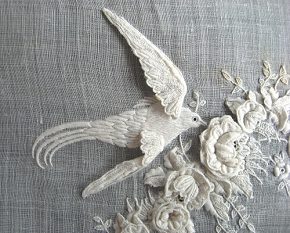
| ANNE WANNER'S Textiles in History / Vocabulary Project |
| There are few copies
left at Textilmuseum St.Gallen, Switzerland |
Euro 12.- + postage, US $ 18 + postage, CHF 15 + postage If you are interested please send an e-mail to I will inform you about possibilities of payment. For sending the booklet I need your postal address. |
P L A T T S T I C H ________________________ |
P A S S E ... P
L A T point de plumetis point de Boulogne ________________________ |
S A T I N S T
I T C H
|
P U N T
O ... P I A T T O punto pieno, punto lanciato punto posato |
| Booklet of 22
pages, in 4 languages (German, English, French
and Italian) Many samplers and diagrams of embroidery stitches in colour. Detail photos of historic embroideries of the Iklé collection, St.Gallen, Switzerland. |
 |
| Author: Anne
Wanner-JeanRichard. Diagrams: Margarete Müller-Schulten. Layout, photos, scans, embroidered stitches: Anne Wanner-JeanRichard. Translation: Elizabeth Fischer (English and French), Thessy Schoenholzer (Italian). Consulting: Ute Bargmann (Conway, MA, USA), Danielle Carl (Montbazon, F.) Marie Schoefer (Lyon, F), Uta-Christiane Bergemann (Bochum, D), Marianne Flügel (Köln, D). Editor: Textilmuseum St.Gallen, Switzerland, © Textilmuseum St.Gallen, Anne Wanner-JeanRichard. ISBN 978-3-033-02554-7, Photonachweis Textilmuseum St.Gallen Niedermann Druck AG, St.Gallen, 2010 |
Acknowledgements My gratitude goes to the Iklé-Frischknecht Foundation for its financial support of the project. The textile examples from the Iklé-Jacoby collection were made available thanks to Hanspeter Schmid, director of the St. Gallen Textile Museum, Ursula Karbacher, curator and Janina Hauser, textile conservator. I am indebted to my husband Rene Wanner for expert advice and technical assistance on digital presentation. Thanks are also due to all CIETA colleagues who encouraged this endeavour through our many discussions during conferences and meetings. |
The
project of a glossary of embroidery stitches arose
among the members of the „Embroidery Group“,
one of the specialized groups under the banner of the
CIETA (Centre International d’Etude des Textiles
Anciens, based in Lyon). |
The great variety of names given to the stitch can be explained by the following characteristics. This embroidery technique requires nothing but a needle, embroidery thread and some ground fabric that is, a minimal kit. However, the breadth of its applications is wide and the shapes it takes are extremely varied. A single stitch may be given several different names, related to materials, to the function of the embroidered textile or its origin. Furthermore, two stitches may appear identical yet not be worked in the same manner. For example, by working the thread in a specific way, precious material may be used sparingly or the ground fabric may be reinforced. Careful analysis of the reverse generally reveals the way in which the embroidery was done. Quite often, the embroidery is done in an individualistic manner. The work doesn’t necessarily have to be done from left to right, nor respectively, from top to bottom and back. In the case of small embroidery pieces, it is of little consequence if the direction of the work is not systematic. |
| Examples of Stitches |
Straight Satin Stitch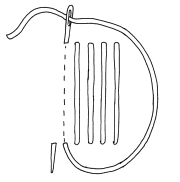 |
front |
reverse |
Slanted and irregular Satin
Stitch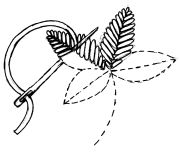 |
front |
reverse |
Raised Satin Stitch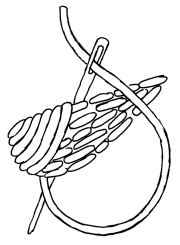 |
front |
reverse |
Surface Satin Stitch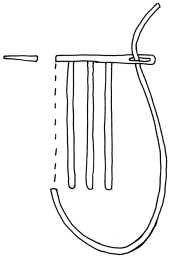 |
front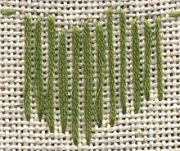 |
reverse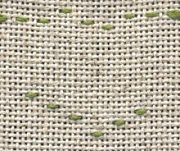 |
Self Couching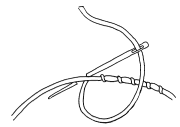 |
front |
reverse |
| Indoportuguese Embroidery |
front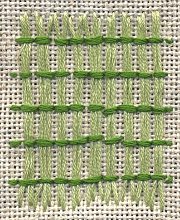 |
reverse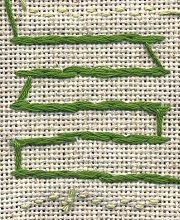 |
In the booklet there are examples of |
|
| Fine Whitework Embroidery
in Eastern Switzerland A delicate technique of whitework embroidery flourished in eastern Switzerland during the 19th century. It was characterised by the use of finest white cotton yarn on muslin ground, equally white, with fillings in needle-point lace, elaborate hemstitching, open- and pulled work, the so-called “zughöhl”, as well as in raised satin stitch. The application of richly embroidered pieces of fabric onto fabric that was already richly embroidered was specific to this type of embroidery. Wilhelm Koch (1823-1897), who came from Hanau in Germany, invented remarkable designs for this embroidery technique. In 1857 he started designing for the firm Custer, Koch & Co. Some 173 embroidery patterns of his have been preserved, depicting miniature scenes in white on blue or brown paper. |
Samples of fabric attached to these designs indicate the desired relief effect. The designs were shown to customers to enable them to place their orders. Once the design had been transferred to transparent paper, its outlines were punched out with a fine needle; dark coloured powder was then sprinkled over the holes so as to mark the fabric beneath with the pattern. After this operation the embroidery work could begin. Little is known about the hundreds of women embroiderers who were engaged in this activity. The earliest industrial statistics, established in 1880 for the cantons of Sankt Gallen, Appenzell and Thurgau, count 2330 male and female embroiderers. |
| home | Last revised October, 2012 |